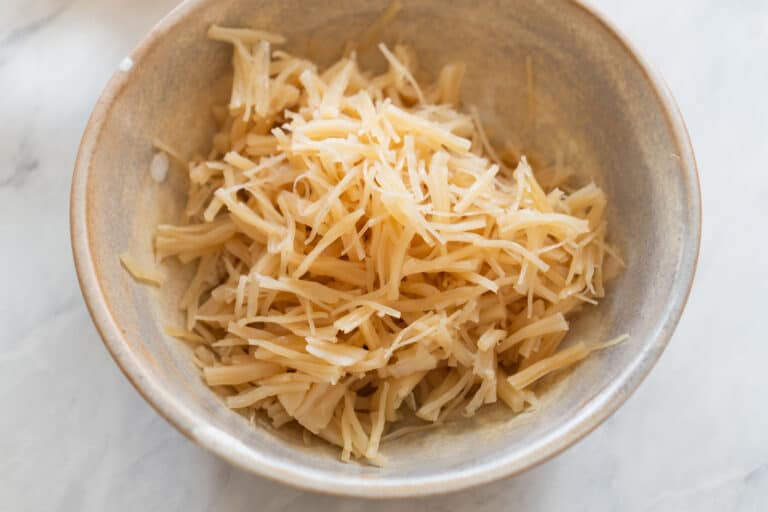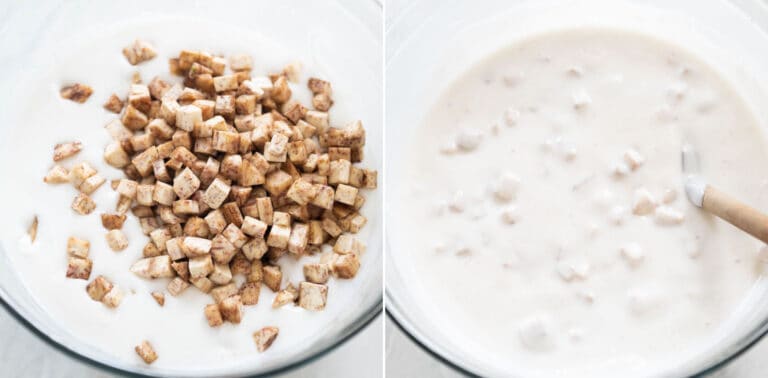Servings: 10
Steamed Taro Cake
This taro cake is something that Mama Lin makes for many Chinese holidays. In my mom’s written recipe, she listed the ingredients according to their weight. I recommend using a scale, if you have one because it’ll make measuring the ingredients much easier. That said, this recipe is very forgiving, so it’s okay if you don’t have a scale.You can use a 9x2-inch round cake pan, a 9-inch springform cake pan, or a 9x9-inch square pan to steam the taro cake. The cake comes out very easily in one piece when you use a springform pan. Although it’ll be difficult to resist, let the cake cool for at least 1 to 2 hours before slicing into it, the longer the better. The cake needs time to cool and set before you cut into it. Otherwise, you’ll end up with a sloppy mess.
Equipment
- 9x2-inch cake pan, 9-inch springform pan, or 9x9-inch square pan
- oil for greasing cake pan
- large wok
Ingredients
Topping
- 1/3 cup (30g) medium-sized dried shrimp
- 2 tablespoons (20g) dried scallops
- 1 1/2 tablespoons oil, any oil works
- 1/3 cup (45g) finely diced shallots
- scant 1/4 cup (30g) finely chopped Chinese sausage
- scant 1/4 cup (30g) finely chopped Chinese cured pork
- 2 tablespoons (20g) finely chopped preserved radish, optional (see note 1)
- 3 tablespoons (15g) sliced scallions
- 1/2 teaspoon kosher salt, 1/4 teaspoon table salt
Taro
- 1 1/2 tablespoons oil, any oil works
- 4 cups (500g) diced taro, about 1/4 to 1/2-inch cubes, (see note 2)
- 1 1/2 teaspoon garlic salt, (I use Lawry's, see note 3)
- 1 teaspoon five-spice powder
- 1/2 teaspoon ground white pepper
Batter
- 1 3/4 cups (240g) rice flour
- 1/4 cup (35g) wheat starch
- 1 teaspoon (4g) Diamond Crystal kosher salt, 1/2 teaspoon table salt
- 4 1/2 cups (1050g) water, divided
Instructions
Prepare Dried Seafood
- This step will take some time, so be patient. Soak the dried shrimp with warm or hot water for 15 minutes and then drain the water. You can keep the water for cooking; in this recipe, you can even save the water for the batter. If any pieces of soaked dried shrimp look larger than 3/4 inch in diameter, slice them in half.
- Dry scallops need a longer soak for this recipe because they need to be shredded apart. Soak the scallops in warm or hot water for 45 minutes. Then, check to see if the scallops have softened. If the center is still pretty firm, drain the water and soak the scallops with more warm or hot water for another 30 to 45 minutes. If you’re using very large dried scallops, you may need to soak them for a longer period. I also like to save the water used for soaking dried scallops for cooking. Once the scallops are soft, shred them with your hands.

Sauté Topping & Taro
- Heat 1 1/2 tablespoons of oil in a wok over high heat. Add the shallots and sauté for about 1 minute. Add the dried shrimp and cook for about a minute. Next, add the Chinese sausage and Chinese cured pork, and toss together for another minute. Next, add the shredded scallops, preserved radish (if using), scallions, and salt and toss together. Turn off the heat and dish up the topping. Set it aside.
- Drizzle another 1 1/2 tablespoons of oil to the wok over high heat. Add the diced taro and sauté for about 1 minute. Then, add the garlic salt, five-spice powder, and white pepper and toss everything together. Turn off the heat and transfer the taro to a plate.
Make Batter
- Add the rice flour, wheat starch, and salt to a mixing bowl and whisk together. Add 1 1/2 cups water (350g) to the flours and whisk until you no longer see flour lumps. I usually like to use some of the reserved liquid from soaking the dried seafood for this.
- Bring 3 cups of water (700g) to boil. Pour the boiling hot water to the flours, stirring simultaneously. Keep stirring until you no longer see lumps of flour. If you boil the water using an electric kettle, cover the mixing bowl with a plate or towel, and let the batter sit for another 3 minutes so the batter can thicken further. If you boiled the water on the stovetop, see note 4. Thickening the batter with hot water ensures that the taro cubes don’t sink straight to the bottom when you mix them into the batter.
Assemble Taro Cake
- Add the sautéed taro to the batter. You’ll know the batter is thick enough if the taro pieces don’t sink to the bottom immediately. Stir everything together.

- Grease the cake pan well with oil. Pour the batter and taro into the pan. Make sure the taro cubes are evenly distributed throughout the pan. Spread the topping over the batter in an even layer.

Steam Cake
- Add a steaming rack to a large wok. Fill the wok with water, until there’s about a 1/4-inch gap between the water level and the top of the steaming rack. Cover the wok with a lid and bring the water to boil.
- Place the taro cake over the steaming rack, cover the wok and steam on high heat for 30 minutes. If your burner is very strong, slightly reduce the heat to medium high.
- The water likely will have evaporated considerably after 25 minutes. Using a measuring cup with a spout or a kettle, carefully pour in some water to the bottom of the wok to replenish the water levels. Steam the cake for another 20 to 25 minutes. For reference, the temperature of the cake should be about 200ºF (93ºC) when it’s done. My mom never tests the temperature; she usually stops steaming the cake after 45 to 50 minutes.
- Remove the cake from the wok and place on a cooling rack to cool and set for 1 to 2 hours, the longer the better. While the cake is still hot, sprinkle some sliced scallions over the cake for garnish.
- Cut the cake into pieces and serve. They're great with a bit of Lao Gan Ma chili crisp. If you have any leftovers, refrigerate them. Reheat the cake by pan frying it. Pan frying the taro cake intensifies the earthy flavors of the taro, making the cake taste even better!
Video
Notes
- Preserved radish (蘿蔔乾 or 萝卜干 in simplified characters) is a sweet preserved vegetable that you can find in Asian grocers, particularly ones that sell Chinese ingredients. You can also use preserved salted turnip (冲菜 or 頭菜). You can also find preserved turnips at Asian grocers and they last a long time. I usually keep a small section in the fridge and freeze the rest for longer storage.
- Use large taro: For this recipe, you’ll need to use large taro that are often sold whole or chopped into large sections (usually weighing somewhere between 3 to 6 pounds). When you slice into the taro, you should be able to see lots of purple veins in the center. This variety of taro is starchy and has the earthy flavor that is best suited for this recipe. If you have leftover taro, use it to make my taro waffles!
- Substitution for garlic salt: Use 1 1/2 teaspoons kosher salt (3/4 teaspoon table salt) and 1/4 teaspoon granulated garlic.
- Boiling water on stovetop: If you use a saucepan to boil the water and you pour just-boiled hot water into the batter, the batter can thicken too much and turn into a mashed potato consistency. However, there is an easy fix. Pour 1/2 to 2/3 cup of cold water into the batter. Stir to loosen the batter so that it’s more like a runny pudding consistency. Add more water if necessary.
- Why can't I boil all the water in this recipe? If you use only boiled water to make the batter, the batter will be too thick and you won't be able to incorporate the taro properly.
- What if my batter is too runny? If the consistency of the batter looks like the consistency of milk, cover it with a large plate, lid, or damp towel for several minutes. If the batter is still runny after several minutes, pour the batter into a stainless steel mixing bowl. Then, boil some water in a saucepan and reduce the heat to medium-low. Place the mixing bowl directly over the saucepan. Make sure that the boiling water doesn’t touch the bottom of the bowl. Whisk the batter constantly for several minutes, until the batter looks like a thick chowder. Do not leave the batter untouched during this time because the flours will congeal at the bottom of the mixing bowl.
- Five-Spice Powder: My mom doesn’t like adding five-spice powder to the topping because it will darken the color of the topping, making the taro cake look less vibrant overall. That’s why she chooses to season taro with five-spice powder.
Nutrition
Serving: 1serving | Calories: 238kcal | Carbohydrates: 37.8g | Protein: 5.4g | Fat: 6.4g | Saturated Fat: 1.1g | Cholesterol: 17mg | Sodium: 483mg | Fiber: 2.9g | Sugar: 1.4g
Did you make this recipe?Tag @hellolisalin or leave a star rating and comment on the blog!
